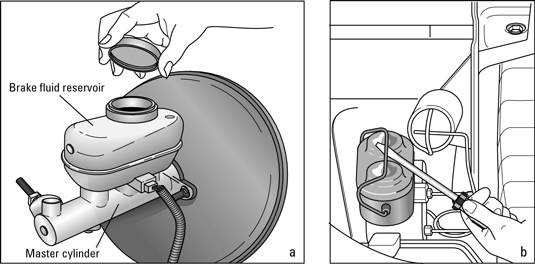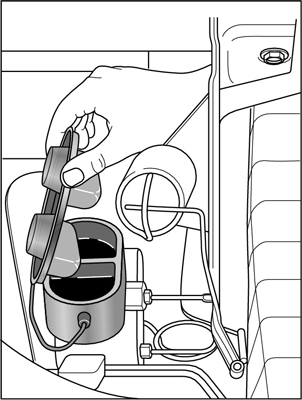In essence, when you inspect your master cylinder, you’re ensuring that the master cylinder, which stores braking fluid, is full. Fluid leaves the master cylinder and enters the brake lines when you press the brake pedal; when you let up on the pedal, the fluid returns to the master cylinder.
The steps below should be followed to inspect the braking fluid in your master cylinder:
Open the brake fluid reservoir on top of your master cylinder.

Simply unscrew the lid from the tiny plastic container that sits on top of the master cylinder if your master cylinder is the type with one. If your reservoir is made of metal, you can pull the holding clamp off the top with a screwdriver.
TIP: When you open the lid, be careful not to let any dirt fall into the chambers. If the area under your hood is covered in grime and dust, wipe the lid before removing it.
Take a look at the lid.

The diaphragm cups in your master cylinder are pushed downward by air that enters through vents in the lid as the brake fluid in your master cylinder recedes (when it is driven into the brake lines). To stop evaporation and keep out dust and particles, the cups lower until they touch the surface of the remaining brake fluid. The cups are raised once more when the fluid flows back in.
NOTE: Before you replace the lid, push the cups back up with a clean finger if your brake fluid level is low or if they are down when you remove the lid.
Examine the master cylinder’s interior.
The braking fluid should be within a half-inch of the top of each chamber or up to the “Full” line on the cylinder’s side. If it isn’t, get the right kind of brake fluid for your car and keep adding it until the line is reached.
As soon as you can, close the brake fluid reservoir to prevent contamination of the fluid by airborne oxygen or water vapor. Additionally, avoid drizzling it on anything as it eats paint!
Close the master cylinder carefully, being careful not to let any dirt fall into it, once both chambers of your master cylinder have been properly topped off with brake fluid.
Unless brake fluid is leaking from another location, you shouldn’t lose much braking fluid because the majority of master cylinders are rather airtight.
Examine the area beneath the master cylinder for stains, moisture, or muck using a flashlight.
You’ll be able to tell if your master cylinder is or has ever leaked by looking closely.




